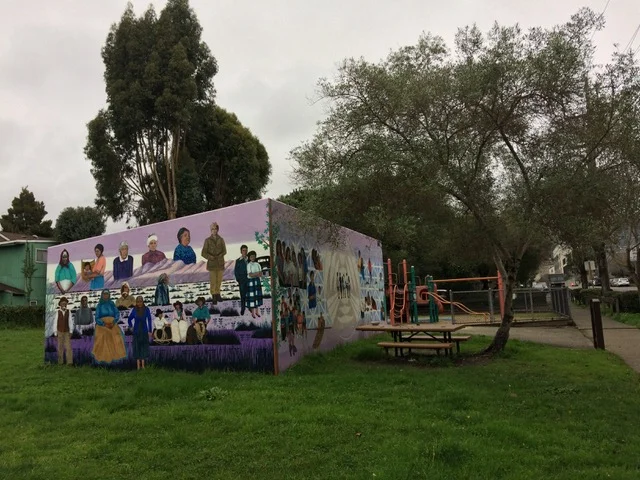BERKELEY CELEBRATES BOTH BEAUTY AND HISTORY
Stephen Most
Stephen Most is a writer and filmmaker. He is the writer/producer of River of Renewal and Wilder than Wild: Fire, Forests, and the Future and the author of Stories Make the World, Reflections on Storytelling and the Art of the Documentary.
On June 1st, 2019, Berkeley celebrates the 50th anniversary of Ohlone Park—a park born in protest over the suppression of People's Park by local police and the California National Guard under Governor Reagan.
The 50th anniversary celebration will include California Indian storytelling and crafts demonstrations as well as a history exhibition, musical performances, a kids' bike rodeo, tai chi demonstrations, and special events at its community garden, dog park, and playgrounds.
This half-block-wide, six-block-long open space along which 30,000 people marched to People's Park in 1969 is itself the result of a protest for beauty's sake. 200 houses had been destroyed for the building of a BART line through that neighborhood, yet Berkeley voters refused to allow BART to run tracks above ground. On June 1st, soon after land had been filled in over the new BART tunnel and two weeks after the assault on People's Park that resulted in the death of James Rector, citizens proclaimed this to be public land from now on and named it the Peoples Park Annex.
Enduring evidence of BART on the liberated land was a stucco slathered vent building at Hearst and Milvia. Painted an ugly green, it was soon crisscrossed with graffiti.
A decade later, inspired by Malcolm Margolin's The Ohlone Way (Heyday Books: Berkeley, 1978), the City renamed the Annex Ohlone Park to honor the indigenous people of the Bay Area, and UC students and Berkeley citizens called for a mural depicting the Ohlone to transform BART's eyesore into a thing of beauty. Some insisted that the mural be created by a California Indian artist.
In 1995, my neighborhood organization Friends of Ohlone Park (FOOP) invited Jean LaMarr (Paiute/Pit River) to paint the four-sided mural that became "The Ohlone Journey." The panel facing a playground to the east, a cartoon-style depiction of the creation story, shows the abundance of life that once thrived in the East Bay. The north panel, based on historic drawings, shows Ohlone villagers doing their welcoming dance. The westward panel, drawn from 20th century photos, honors the lives of Native families of the East Bay. And "The Strong Walk Back to the Future," facing south, represents the determination of the Ohlone People to thrive without sacrificing their traditions or their cultural identity. A civic arts commissioner called this "one of the most revered works of public art" in the city.
Photo courtesy of Bill Newton
However, the funding for the mural project and the support it received from Berkeley's Parks and Civic Arts staff did not enable the artist to realize her vision fully. LaMarr and the Ohlone families who aided her research had worried that the mural would be defaced. They wanted a border area that would keep vandals and graffiti artists away from the panels. LaMarr's solution was an art garden around the mural, with a grinding rock sculpture, redwood benches with inlaid images of swimming salmon, and Native plants growing beside the tule reeds and trees she painted on the mural.
Over the years, taggers left their marks on the Ohlone Mural and vandals gouged it, requiring Civic Arts to do a costly restoration and cleaning and coat it freshly with anti-graffiti varnish.
Finally, in this 50th anniversary year of Ohlone Park, with the aid of the UC Chancellor's community partnership funding, renewed support from Parks and Civic Arts, and a new round of FOOP fund-raising, Jean LaMarr is creating the Ohlone Mural Art Garden.
As an expression of Native culture, this art garden combines practicality and beauty. The Muwekma Ohlone tribe, which offers indigenous meals at their Cafe Ohlone, wants to process acorns, their traditional staple, on the grinding rock. The garden will include plants that provided medicines, basketry materials, soap, tea leaves, and food for thousands of years to the first people of the East Bay.
In contrast to Western gardening traditions, the Native concept of a garden was never confined to walled or bordered spaces. The lands they inhabited and traveled through were their gardens. Perhaps fifty years from now, when the hundredth anniversary of Ohlone Park is celebrated, indigenous plants will grow throughout the park, reducing or eliminating the need for watering, increasing the city's insect populations and biodiversity overall, supporting indigenous culture, and making the land more beautiful for everyone who visits, travels through, and lives near Ohlone Park.
Photo courtesy of Stephen Most




